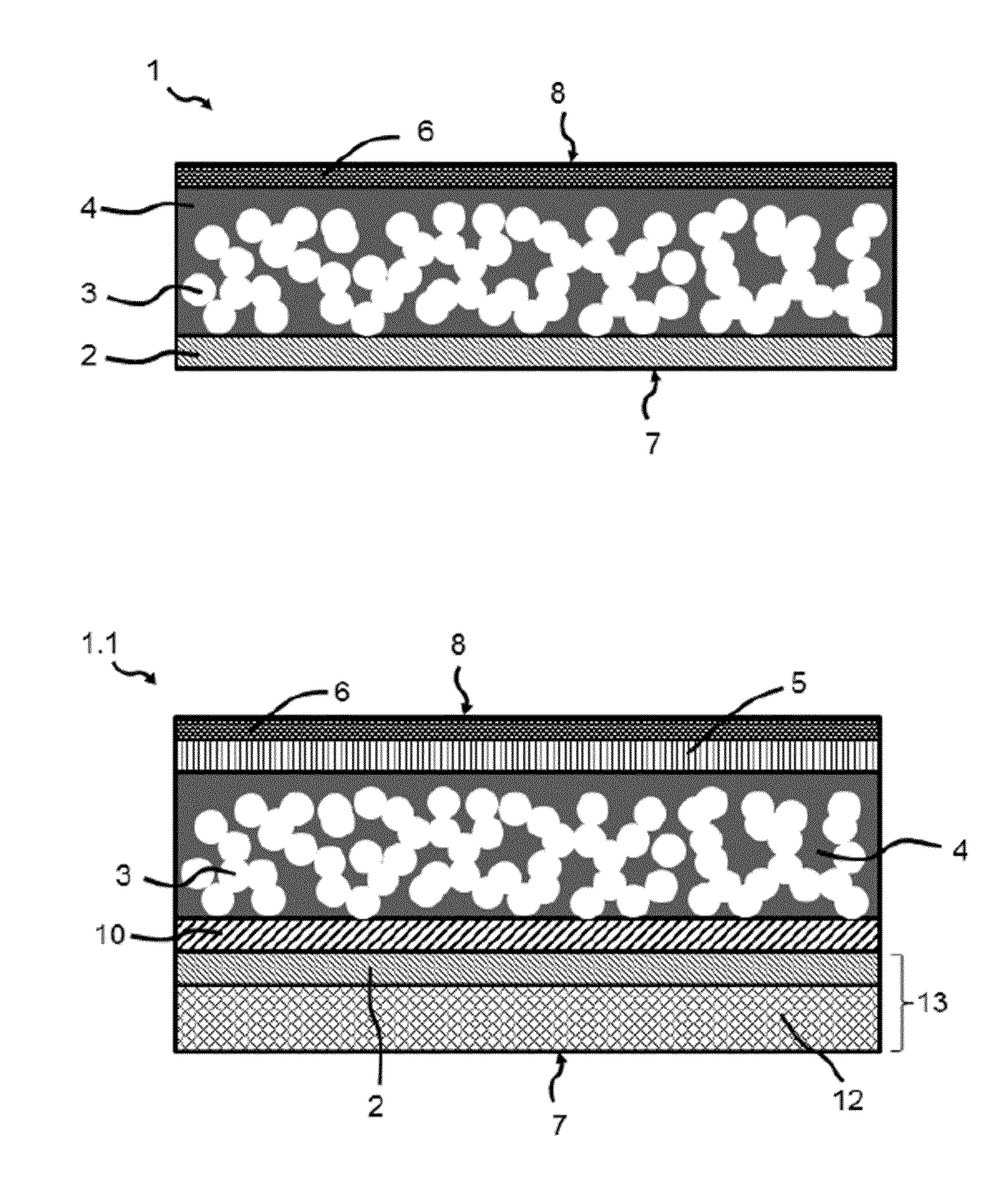High performance perovskite-sensitized mesoscopic solar cells
a solar cell, mesoscopic technology, applied in the field of solar cells, can solve the problems of poor stability of photovoltaic devices, large spread of photovoltaic devices, poor reproducibility and performance of photovoltaic devices, etc., and achieve the effect of low cost, rapid preparation and readily available materials
- Summary
- Abstract
- Description
- Claims
- Application Information
AI Technical Summary
Benefits of technology
Problems solved by technology
Method used
Image
Examples
example 1
Preparation of Perovskite Nanocomposites
[0189]We prepared the mesoporous TiO2 (anatase) films by spin-coating a solution of colloidal TiO2 (anatase) particles onto a 30 nm thick compact TiO2 underlayer. The latter was deposited by aerosol spray pyrolysis on a transparent conducting oxide (TCO) coated glass substrate acting as electric front contact of the solar cell. PbI2 was then introduced into the TiO2 nanopores by spin-coating using a 1.0 M solution in DMF kept at 70° C. Further experimental details are provided in the methods section.
[0190]FIG. 1a presents a cross-sectional SEM photograph of the thus prepared film. The absence of any protruding PbI2 crystals from the surface of the mesoporous anatase layer shows that our infiltration method leads to a structure where the PbI2 is entirely contained within the nanopores of the TiO2 film. We find that the resulting composite has approximately the same optical absorbance as that of a 200 nm thick compact PbI2 film and estimate from...
example 2
Photovoltaic Performance
[0197]We used the sequential deposition technique to fabricate mesoscopic solar cells employing the triarylamine-derivative spiro-MeOTAD as a hole transport material (HTM). FIG. 2 shows a cross sectional SEM picture of a typical device. The mesoporous TiO2 film had an optimized thickness of around 350 nm and was infiltrated with the perovskite nanocrystals using the above-mentioned two-step procedure. The HTM was subsequently deposited by spin coating. It penetrates into the remaining available pore volume and forms a 100 nm thick overlayer on top of the composite structure. A thin gold layer was thermally evaporated under vacuum onto the HTM forming the back contact of the device.
[0198]We measured the current-voltage characteristics of the solar cells under simulated air mass (AM) 1.5 global (G) solar irradiation and in the dark. FIG. 3a shows JV-curves measured at a light intensity of 95.6 mW cm−2 for a typical device. From this we derive values for the sho...
example 3
Long-Term Stability
[0201]In order to test the stability of the perovskite based photovoltaics prepared using the aforementioned procedure we subjected a sealed cell to long term light soaking at ca. 100 mW cm−2 light intensity and 45° C. The device was encapsulated in argon and is maintained under optimal operating conditions during the ageing using maximum power point (MPP) tracking. We find a very promising long-term stability as the photovoltaic device maintains above 80% of its initial PCE after a period of 500 h. Even more importantly, we do not observe any change in short-circuit photocurrent, indicating that there is no photo-degradation of the perovskite light-harvester. The decrease in PCE is therefore only due to a decrease in both open-circuit potential and FF, whereas the similar shape of both decays suggests that they are both linked to the same degradation mechanism. The change in these two parameters is due to a decrease in the shunt resistance as is apparent from FIG...
PUM
 Login to View More
Login to View More Abstract
Description
Claims
Application Information
 Login to View More
Login to View More - R&D
- Intellectual Property
- Life Sciences
- Materials
- Tech Scout
- Unparalleled Data Quality
- Higher Quality Content
- 60% Fewer Hallucinations
Browse by: Latest US Patents, China's latest patents, Technical Efficacy Thesaurus, Application Domain, Technology Topic, Popular Technical Reports.
© 2025 PatSnap. All rights reserved.Legal|Privacy policy|Modern Slavery Act Transparency Statement|Sitemap|About US| Contact US: help@patsnap.com



